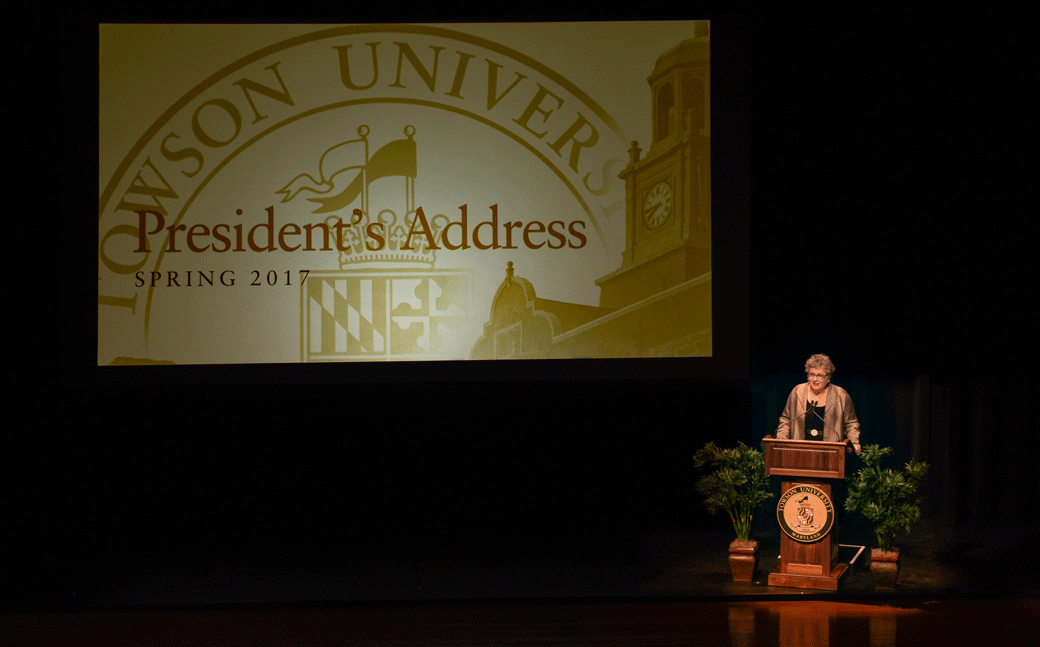Towson University Marriott will be converted to student housing by fall 2018
President Kim Schatzel offers details on anchor scan analysis as part of her spring address to campus

Towson University President Kim Schatzel announced Thursday during her Spring Address to campus that TU will be leveraging a university asset to begin its effort to build stronger connectivity to Greater Baltimore as an anchor institution. To meet the strong demand for upper-division student housing and help offset a 2,000 to 2,500-bed shortage, the university will be concluding its agreement with the Towson University Marriott Hotel at the end of the contract in June 2018, and will reopen the university-owned building as student housing by fall 2018.
Since last fall, Towson University has been working to develop a comprehensive strategy focused on supporting the university’s mission by strengthening connectivity to the local community and emerging businesses.
“This will provide hundreds more much-needed and in-demand apartment-style beds to campus faster and for significantly less than we could ever build them,” Schatzel told a packed Stephens Hall Theatre audience. “This efficiency and effectiveness effort will allow us to better leverage this campus asset and its prime location, thus connecting us to the core of downtown Towson.”
Towson University has shifted toward a more residential campus in recent years. About 87 percent of full-time freshmen live on campus, and demand for housing has surpassed capacity. Record enrollment growth is expected again this fall, which will increase demand for more student housing. Current housing options for juniors, seniors, transfer and international students are particularly limited.
“Our current student housing supply cannot address the transfer students who make up half of our undergraduate enrollment mix,” Schatzel said. “When those transfer students arrive at TU, we have no place for them to call home and establish connections to campus that will support their academic and personal success.”
This need for student housing aligns with the TIGER Way presidential priority, which offers a strategy for providing more support for all students, especially transfer and graduate students, as they launch into their studies at TU.
For years, as part of its master planning process, TU reviewed market trends and assessed mission-critical capital needs of the university to develop the campus. An “anchor scan” conducted by Margrave Strategies, which began last fall, marks the first time the university looked beyond its campus borders to maximize the strategic assets in the area.
Margrave Strategies recently shared their data analysis and research findings—including information about TU employees, working trends in the Towson area, the critical demand for student housing, and attractive amenities and opportunities for the surrounding community. Information is posted on a microsite on the university’s website.
“All of this research, as well as the recent market analysis we completed for student housing, points to real opportunities to match the incredible demand with the supply,” Schatzel noted. “On the student housing front alone, TU’s demand for student housing is only increasing more rapidly now than ever before.”
Schatzel said Thursday that in the future, the university might also consider other uptown attractions such as a coffee shop, a satellite of the campus bookstore and gallery space to better showcase the creative work of faculty and students.
“This is about sustainable community and economic development that ultimately helps us attract and retain the best and brightest faculty, staff and students,” Schatzel said during her address. “And it’s happening in cities across the country, including the University of Pennsylvania in West Philadelphia, the University of Michigan in Ann Arbor, the University of Chicago, and more.
“We will continue to digest and review what all of this information means in the days, weeks and months ahead,” Schatzel added. “Where and when the right opportunities and assets which meet our institutional mission become available, we’ll move forward.”
Over the next 15 to 18 months, university leadership will meet with various groups and organizations, elected leaders, and local communities to discuss a variety of considerations, including parking and the potential use of the Towson University Marriott’s conference center space as offices.
Schatzel said the anchor scan analysis will enable the university to look at the big picture off-campus, rather than one-at-a-time opportunities as they “pop-up.”
“This is how we will build a strong foundation for this university’s most promising future,” she added.
This story is one of several related to President Kim Schatzel's priorities for Towson University: BTU: Partnerships at Work for Greater Baltimore, Strategic Plan Alignment and TIGER Way